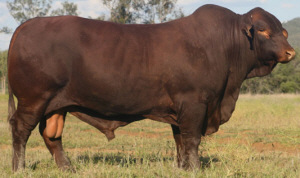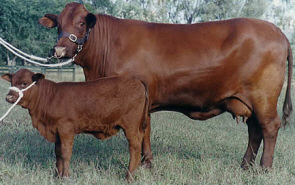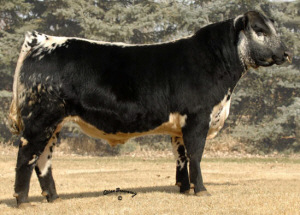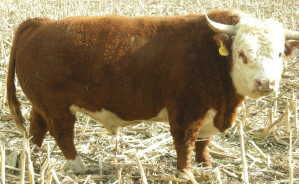



Santa Gertrudis
History
The Santa Gertrudis breed of cattle, named for the Spanish land grant where Captain Richard King first established the King Ranch, were developed to thrive, prosper and gain weight on the native grasses of the South Texas brush country. The first and perhaps the most enduring efforts to produce the rugged breed began in 1910 when the King Ranch decided to systematically crossbreed its Shorthorn and Hereford cattle with Brahman. After a few crosses, the Brahman X Shorthorn cross showed the most promise, and the ranch headed toward a cross of 3/8 Brahman and 5/8 Shorthorn as the optimum blend of the two breeds.
 Photo courtesy of Gyranda Santa Gertrudis Stud, Australia www.gyranda.com.au |
By 1940 a large herd of these improved cattle had been evolved on King Ranch with the animals breeding true to type. In that year, Santa Gertrudis was recognised by the United States Department of Agriculture as a pure breed.
Today Santa Gertrudis are referred to as America's original beef breed. Santa Gertrudis were developed for survival and throughout the years enhanced for profitability.
Characteristics
The Santa Gertrudis is red in colour and display a blend of Bos indicus and Bos taurus attributes. They have a short, straight slick coat with loose and moveable skin which is red in pigmentation. Their confirmation is broad, strong and well muscled, they may be polled or horned.
Mature Santa Gertrudis bulls weigh in excess of 900 kg and a mature Santa cow can weigh up to 750kg. Daily weight gains of Santa Gertrudis bulls is regularly monitored at more than 1.5kg per day.
Females with adequate conditions will breed at 12-14 months of age and produce their first calf as a two-year old. The Santa Gertrudis is an above average producer of milk. Due to this heavy milk production she will also wean a heavier calf.
A female can remain in production well past her 12th birthday and may stay in the breeding herd as long as 18 years.
Santa bulls have outstanding foraging ability which means they can thrive even under the harshest conditions and they are noted as very active and athletic sires.
 Photo courtesy of Gyranda Santa Gertrudis Stud, Australia www.gyranda.com.au |
Their thick hide serves as insulation to the cold and as a barrier to insects and parasites. The presence of sweat glands in their loose hide also helps thrm dissipate heat in warm environments. Santa Gertrudis are very disease resistant and will stay healthy in feedlots and confined environments. Santa Gertrudis cattle are hardy animals that will travel long distances in search of forage or water.
Statistics
Comparative
At a recent Texas A&M University Ranch to Rail feeding trial, a pen of purebred Santa Gertrudis steers had a net profit of $100.87 per head. This compares to a minus $50.29 for 1334 steers from 137 ranches. Santa Gertrudis steers, purebred or cross prove that they can gain above and beyond the national average when in the feedlot.
In a recent test of purebred Santa Gertrudis steers fed at the Circle E Feedlot in Potwin, Kansas the average daily gain for this set of 116 steers was 3.84 pounds. These steers were fed for 133 days.
In another test, purebred Santa Gertrudis steers from Alabama were shipped to Heritage Beef Cattle Company in Wheeler, Texas. This group of 58 steers were fed for 163 days. They had a daily gain of 3.93 pounds per day and a feed conversion rate of 5.95. The total cost of gain was $41.27.
In a South Texas bull gain test, 64 Santa Gertrudis bulls performed quite well in comparison with the other breeds represented. Bulls were fed for 112 days. The average final weight for these bulls was 1060 pounds, the average daily gain was 3.61 and backfat was .20.
http://santagertrudis.com
Distribution
The Santa Gertrudis are being produced in North and South America, and Australia.
References (the above information was cited from the following sites)
http://santagertrudis.com
www.santagertrudis.com.au
www.gyranda.com.au


